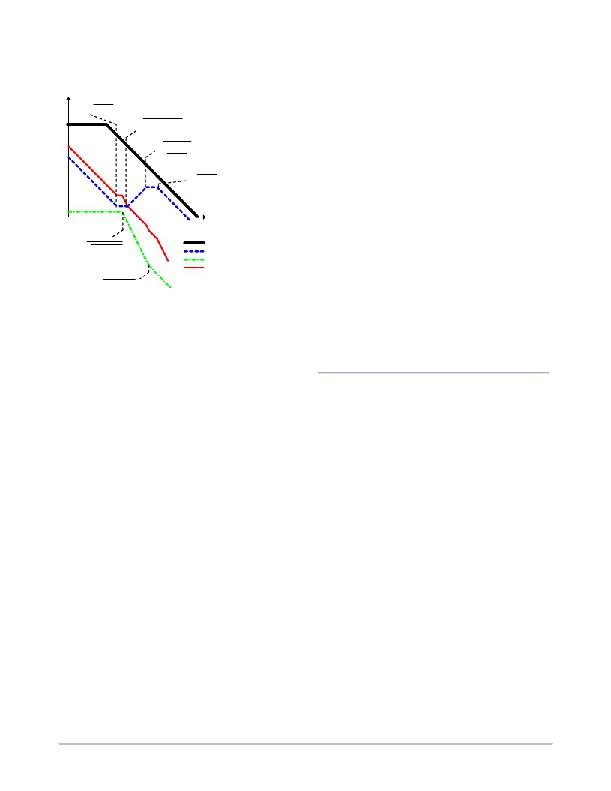- 您现在的位置:买卖IC网 > Sheet目录346 > NCV8855BMNR2GEVB (ON Semiconductor)BOARD EVALUATION NCV8855 ASIC
�� �
�
NCV8855�
�control� loop� has� a� gain� crossing� with� ?� 20� dB/decade� slope�
�and� a� phase� margin� greater� than� 45� °� .�
�gain� =� 0� dB� or� a� gain� of� 1.� In� the� plot� above,� the� UGB� is� the�
�point� where� the� red� line� crosses� the� W� axis.� Goal� 2� is� to� have�
�the� closed� loop� gain� cross� 0� dB� with� a� ?� 20� dB/decade� slope�
�dB�
�w� Z1� +�
�1�
�R� 2� @� C� 2�
�w� Z2� +�
�1�
�R� 1� )� R� 3� @� C� 3�
�1�
�w� P1� +�
�C� 1� @� C� 2�
�C� 1� )� C� 2�
�w� P2� +�
�1�
�R� 3� @� C� 3�
�also� known� as� a� ?� 1� slope.� Goal� 3� is� to� achieve� over� 45� °� of�
�phase� margin� when� the� gain� crosses� 0� dB.�
�These� are� just� goals.� Sometimes� the� crossover� frequency�
�is� reduced� below� 1/10� FSW� in� order� to� meet� goal� 3.�
�Conversely,� some� designs� will� push� the� crossover� frequency�
�as� high� as� it� can� (as� long� as� it� is� below� 1/2� FSW)� with� a�
�reduce� phase� margin� of� 30� °� in� order� to� get� a� faster� transient�
�response.� The� only� two� absolutes� are� that� the� crossover�
�frequency� cannot� exceed� 1/2� FSW� and� the� phase� margin� has�
�w�
�to� be� greater� than� 0� °� at� crossover.� However,� a� SMPS�
�operating� towards� these� absolutes� will� experience� sever�
�ringing� before� it� dampens� out.�
�1�
�w� LC� +�
�L� OUT� @� C� OUT�
�1�
�w� ESR� +�
�ESR� @� C� OUT�
�Error� Amplifier�
�Compensation� Network�
�Modulator� Gain�
�Closed� Loop� Gain�
�To� achieve� the� above� goals,� the� following� guidelines�
�should� be� adopted.�
�?� Place� wZ1� at� half� the� resonance� of� wLC�
�?� Place� wZ2� at� or� around� wLC�
�?� Place� wP1� at� wESR�
�Figure� 27.�
�To� reiterate,� there� are� 3� primary� goals� to� compensating.�
�Goal� 1� is� to� have� a� high� a� unity� gain� bandwidth� (UGB)� that�
�is� greater� than� 1/10� the� switching� frequency,� but� less� than� 1/2�
�the� switching� frequency.� UGB� is� also� known� as� the�
�crossover� frequency.� This� is� the� point� where� the� closed� loop�
�?� Place� wP2� at� half� the� switching� frequency�
�Performing� these� calculations� will� take� some� amount� of�
�iterations� and� bench� testing� to� verify� results.� However,�
�ON� Semiconductor� has� developed� a� tool� to� speed� up� the�
�design� process� tremendously� with� great� ease� and� accuracy.�
�This� tool� can� be� downloaded� by� following� the� below� link.�
�http://www.onsemi.com/pub/Collateral/COMPCALC.ZIP�
�http://onsemi.com�
�21�
�发布紧急采购,3分钟左右您将得到回复。
相关PDF资料
NCV8871BSTGEVB
BOARD EVAL NCV8871BST BOOST CTLR
NHC-14150
VALULINE 8" X 8.5" X 1.75"
NHC-14151
VALULINE 8" X 17" X 1.75"
NHC-14152
VALULINE 13" X 17" X 1.75"
NHC-14153
VALULINE 8" X 8.5" X 3.5"
NHC-14154
VALULINE 8" X 17" X 3.5"
NHC-14155
VALULINE 13" X 17" X 3.5"
NHC-14156
VALULINE 13" X 17" X 5.25"
相关代理商/技术参数
NCV8870
制造商:ONSEMI 制造商全称:ON Semiconductor 功能描述:Automotive Grade Non-Synchronous Boost Controller
NCV887000
制造商:ONSEMI 制造商全称:ON Semiconductor 功能描述:Automotive Grade Non-Synchronous Boost Controller
NCV887000D1R2G
功能描述:低压差稳压器 - LDO Auto Grade Non-Sync Boost Controller
RoHS:否 制造商:Texas Instruments 最大输入电压:36 V 输出电压:1.4 V to 20.5 V 回动电压(最大值):307 mV 输出电流:1 A 负载调节:0.3 % 输出端数量: 输出类型:Fixed 最大工作温度:+ 125 C 安装风格:SMD/SMT 封装 / 箱体:VQFN-20
NCV887001
制造商:ONSEMI 制造商全称:ON Semiconductor 功能描述:Automotive Grade Non-Synchronous Boost Controller
NCV887001D1R2G
功能描述:低压差稳压器 - LDO Auto Grade Non-Sync Boost Controller
RoHS:否 制造商:Texas Instruments 最大输入电压:36 V 输出电压:1.4 V to 20.5 V 回动电压(最大值):307 mV 输出电流:1 A 负载调节:0.3 % 输出端数量: 输出类型:Fixed 最大工作温度:+ 125 C 安装风格:SMD/SMT 封装 / 箱体:VQFN-20
NCV887100D1R2G
功能描述:DC/DC 开关控制器 AUTOMOTIVE-GRADE NON-SYNC RoHS:否 制造商:Texas Instruments 输入电压:6 V to 100 V 开关频率: 输出电压:1.215 V to 80 V 输出电流:3.5 A 输出端数量:1 最大工作温度:+ 125 C 安装风格: 封装 / 箱体:CPAK
NCV887101D1R2G
功能描述:IC REG CTRLR BST PWM CM 8-SOIC RoHS:是 类别:集成电路 (IC) >> PMIC - 稳压器 - DC DC 切换控制器 系列:- 产品培训模块:Lead (SnPb) Finish for COTS
Obsolescence Mitigation Program 标准包装:2,500 系列:- PWM 型:电流模式 输出数:1 频率 - 最大:275kHz 占空比:50% 电源电压:18 V ~ 110 V 降压:无 升压:无 回扫:无 反相:无 倍增器:无 除法器:无 Cuk:无 隔离:是 工作温度:-40°C ~ 85°C 封装/外壳:8-SOIC(0.154",3.90mm 宽) 包装:带卷 (TR)
NCV887102D1R2G
功能描述:IC REG CTRLR BST PWM CM 8-SOIC RoHS:是 类别:集成电路 (IC) >> PMIC - 稳压器 - DC DC 切换控制器 系列:- 产品培训模块:Lead (SnPb) Finish for COTS
Obsolescence Mitigation Program 标准包装:2,500 系列:- PWM 型:电流模式 输出数:1 频率 - 最大:275kHz 占空比:50% 电源电压:18 V ~ 110 V 降压:无 升压:无 回扫:无 反相:无 倍增器:无 除法器:无 Cuk:无 隔离:是 工作温度:-40°C ~ 85°C 封装/外壳:8-SOIC(0.154",3.90mm 宽) 包装:带卷 (TR)